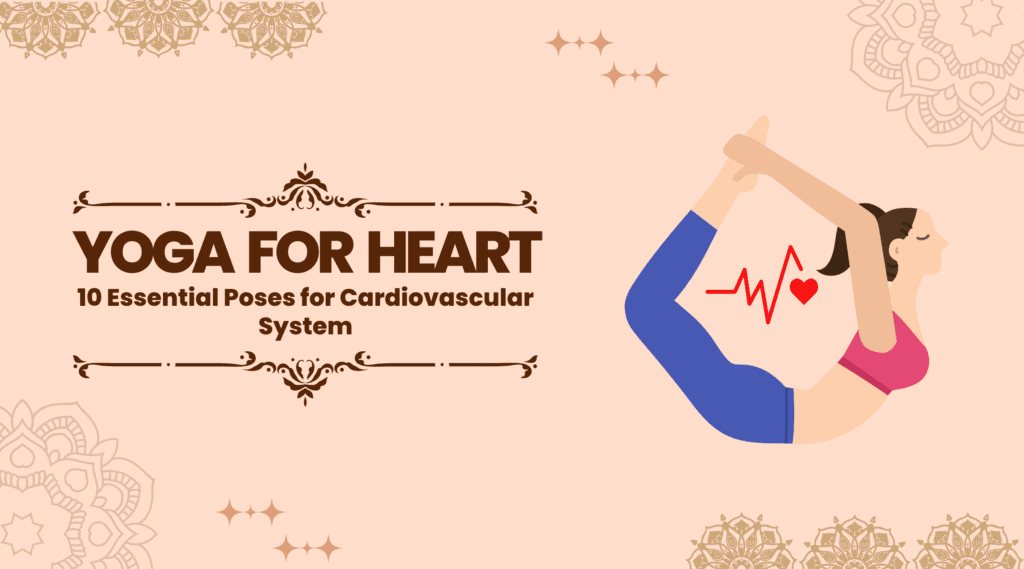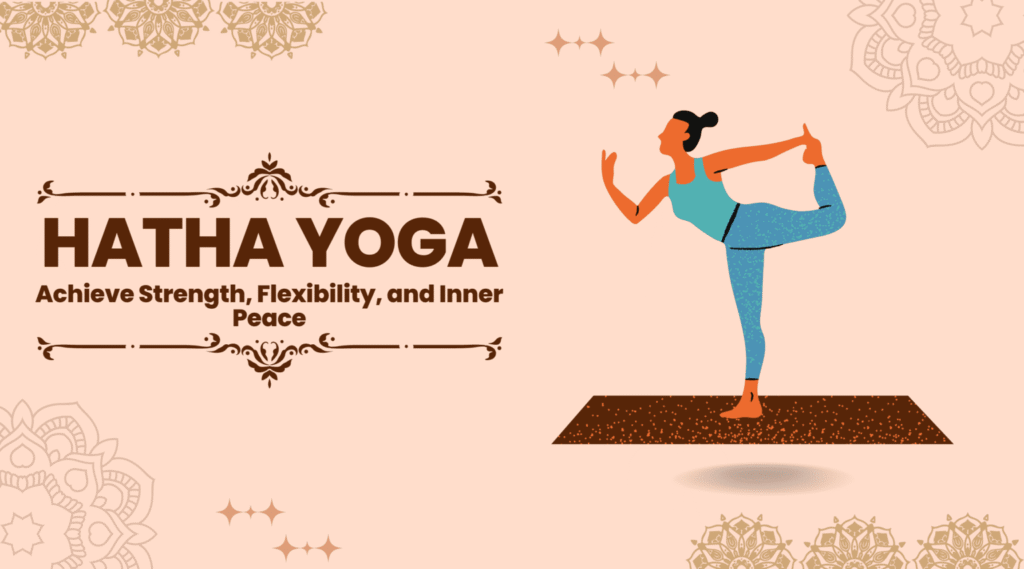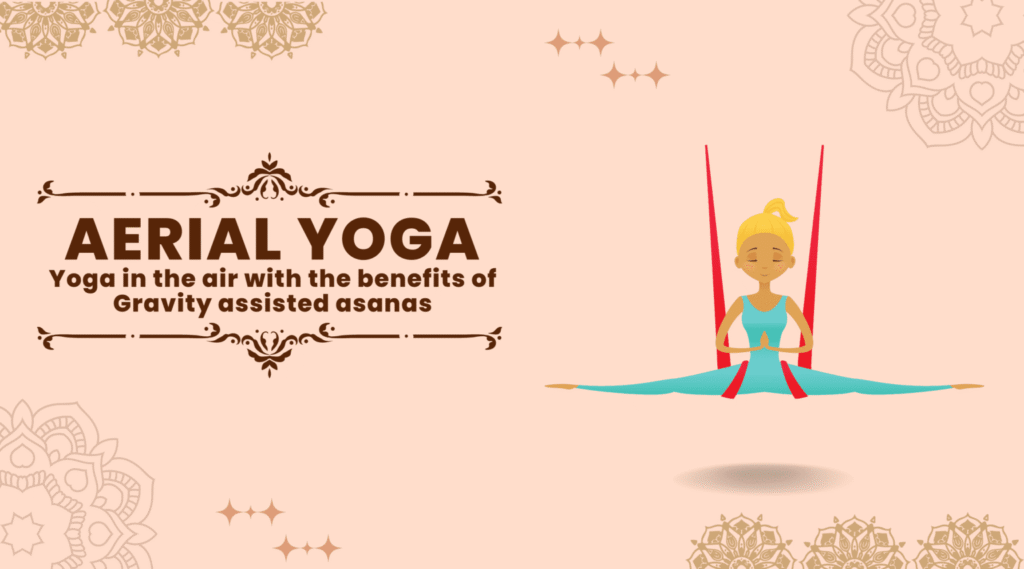
An Introduction
Yoga for Heart is a great idea. Yoga is a holistic practice that involves Yoga poses (physical postures), breath control, and meditation. The practice of yoga has numerous health benefits, which includes improving Cardiovascular System also. Heart problems are one of the main causes of death worldwide, but we can reduce the risk of heart disease by incorporating yoga into your daily routine. There are Yoga Poses for Heart, which can improve cardiovascular health and keep a person’s heart healthy. As a low-impact exercise, yoga is accessible to people of all ages and fitness levels and can be an effective tool in maintaining heart health.
How Yoga Helps To Keep Cardiovascular System Healthy
Yoga has been shown to have a positive effect on the heart in a number of ways. Here are the ways how yoga helps to maintain a healthy heart:
Reducing Stress and Anxiety
One of the most significant benefits of yoga for cardiovascular system is its ability to reduce stress. Stress and anxiety are known to have a negative impact on heart health, and hence it is one of the major risk factors for heart disease. Practising yoga regularly can help reduce stress and anxiety levels, which can have a positive impact on heart health. Yoga is also known to activate the parasympathetic nervous system, which helps to calm the mind and reduce stress.
Reducing Blood Pressure
High blood pressure is also a common risk factor for heart disease. Yoga can be an effective tool in reducing blood pressure levels. Practising yoga regularly has been shown to lower both systolic and diastolic blood pressure.
Lowering Cholesterol Levels
High cholesterol levels are another risk factor for heart disease. Yoga can be an effective way to lower cholesterol levels. A study published in the Journal of Evidence-Based Complementary & Alternative Medicine found that practising yoga for eight weeks helped lower cholesterol levels in participants.
Improving Cardiovascular Endurance
Yoga offers effective support to cardiovascular function by improving cardiovascular endurance. The physical postures in yoga are designed to improve strength, flexibility, and balance, which can help improve cardiovascular function and overall fitness levels. As cardiovascular endurance improves, the heart becomes stronger, which can help reduce the risk of heart disease.
10 Best Yoga Poses for Cardiovascular System
There are Heart Opening Yoga Poses (backbend yoga postures)which improve cardiovascular health. They are also known as chest opening poses, Heart Chakra Yoga Poses, Heart Opener Yoga Poses or simply Heart Openers. These yoga poses help to improve circulation and oxygenation to the heart. And hence these postures help to increase the elasticity of the arteries as well as improve the blood flow, which helps to reduce the risk of heart disease. Here are a few of the best yoga poses for heart:
1. Anahatasana
Also known as Melting Heart Pose, is a heart-opening yoga pose that stretches the chest, shoulders, and spine. It’s a gentle variation of Child’s Pose that provides a deep release for the upper body.
To perform Anahatasana, start in a tabletop position on your hands and knees with your wrists directly under your shoulders and your knees under your hips. Take your hands in the forward direction as far as you can and place your hips over the knees. Lower your chest towards the ground, keeping your arms extended and your elbows off the ground. Now keep your forehead on the mat. Relax your neck. You should feel a stretch in your chest and shoulders.
If you want a deeper stretch, you can extend your arms forward and bring your forehead to the ground. Stay in the pose for several deep breaths, allowing your body to soften and release any tension in your upper body.
2. Camel Pose (Ustrasana)
Camel Pose stretches the entire front body such as the chest, abdomen, hip flexors etc. To perform this pose, start by kneeling on the floor with your knees hip-width apart. Keep your hands on the lower back while fingers in a pointing down position. Inhale and lift your chest, pressing your hips forward. Reach back with your hands and place them on your heels. Hold the pose for some time and then release.
3. Cobra Pose (Bhujangasana)
Cobra Pose is a gentle backbend that stretches the chest, shoulders, and spine. To perform this pose, start by lying on your stomach with your hands placed under your shoulders. Now lift your chest off the ground while inhaling, keep your elbows close to your body.
4. Upward-Facing Dog Pose (Urdhva Mukha Svanasana)
Upward-Facing Dog Pose is a more intense backbend that strengthens the arms, shoulders, and back muscles while stretching the chest and abdomen. To perform this pose, start by lying on your stomach with your hands placed under your shoulders. Inhale and straighten your arms, lifting your chest off the ground. Keep your thighs and hips off the ground and press the tops of your feet into the floor.
5. Bow Pose (Dhanurasana)
Bow Pose is a deep backbend that stretches the entire front of the body, including the chest, abdomen, and hip flexors. To perform this pose, start by lying on your stomach with your arms at your sides. Inhale and bend your knees, reaching back with your hands to grab your ankles. Lift your chest and thighs off the ground, holding the pose for several breaths before releasing.
6. Mountain Pose (Tadasana)
Mountain Pose is a simple standing pose that helps improve posture and strengthen the muscles of the legs and core. This pose can help improve cardiovascular endurance and reduce the risk of heart disease.
7. Warrior II (Virabhadrasana II)
Warrior II is a standing pose that helps improve strength and flexibility in the legs, while also improving balance. This pose can help improve cardiovascular endurance and reduce the risk of heart disease.
8. Tree Pose (Vrikshasana)
Tree Pose is a balancing pose that helps improve balance and stability, while also strengthening the muscles of the legs and core. This pose can help improve cardiovascular endurance and reduce the risk of heart disease.
9. Bridge Pose (Setu Bandhasana)
Bridge Pose is a backbend pose that helps improve flexibility in the spine, while also strengthening the muscles of the legs, glutes, and core. This pose can help improve cardiovascular endurance and reduce the risk of heart disease.
10. Wheel Pose (Urdhva Dhanurasana)
Wheel Pose is a challenging backbend that strengthens the arms, shoulders, and back muscles while stretching the chest, abdomen, and hip flexors. To practise wheel pose, lay down on your back, keep your knees bent and your feet flat on the ground. Place your hands next to your ears, fingers pointing toward your shoulders. Inhale and press into your hands and feet, lifting your hips and chest off the ground.
Apart from yoga poses, Breath control, or pranayama, is also an important component of yoga for heart health. Pranayama techniques, such as deep breathing and Ujjayi breathing, can help to reduce stress and anxiety, lower blood pressure, and improve overall cardiovascular function. Pranayama can also help to improve lung function, which is important for oxygenating the blood and promoting heart health.
Meditation is also key component of yoga for cardiovascular system health. Meditation has been shown to have numerous health benefits, including reducing stress, lowering blood pressure, and improving cardiovascular function. Regular meditation can also help to reduce the risk of heart disease and improve overall well-being.
This way, incorporating yoga into your daily routine can have a significant impact on heart health.
Conclusion
Yoga is a powerful tool for promoting heart health. By reducing stress, improving cardiovascular function, as well as promoting relaxation, yoga helps to reduce the risk of heart disease hence it is always beneficial to incorporate yoga for the optimal health of the cardiovascular system as well as overall well-being. However, It is important to work with a qualified yoga teacher to ensure that you are practising the correct postures and techniques for your individual needs. It is also important to consult with your healthcare provider before beginning any new exercise routine, especially if you have a history of heart disease or other cardiovascular conditions.


